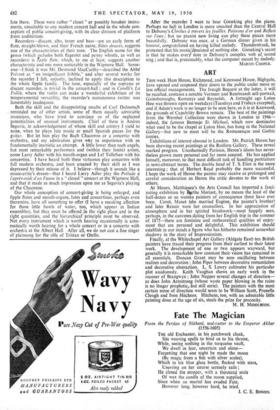ART
THIS week Ham House, Richmond, and Kenwood House, Highgate, have opened and reopened their doors to the public under more or less official managements. The Iveagh Bequest at the latter, it will be recalled, contains a notable Vermeer and Rembrandt self-portrait, Gainsboroughs, Romneys and Reynolds. A fortnight ago Luton Hoo was throvin open on weekdays (Tuesdays and Fridays excepted), and if Adam's work is no longer to be seen here, as it is at Kenwood, the grounds of Capability Brown remain. The best of the paintings from the Wernher Collection were shown in London in 1946— indeed, the famous Bermejo St. Michael, which now dominates what used to be the chapel at Luton Hoo, has hung in the National Gallery—but new to most will be the Romanesque and Gothic ivories.
Exhibitions of interest abound in London. Mr. Patrick Heron has been showing recent paintings at the Redfern Gallery. These reveal marked progress. Unashamedly Parisian, Heron's idiom has never- theless grown more personal and far more assured. He has applied himself, moreover, to that most difficult task of handling portraiture in semi-abstract terms., The double head of T. S. Eliot is the more interesting ; that of Herbert Read probably the more successful. I hope the work of Heron the painter may receive as prolonged and careful consideration as Heron the critic devotes to the work of others.
At Messrs. Matthilitors the Arts Council has imported a fasci-
nating exhibition by the Morisot, by no means the least of the half-dozen or so women painters of consequence there have ever been. Corot, Manet (she married Eugene, the painter's brother) and later Renoir were her counsellors. In her appreciation of atmosphere and in her spirited brushwork—most happily seen, perhaps, in the canvases dating from her English trip in the summer of 1875—there are feminine and untheoretical qualities of enjoy- ment that are personal and delightful. This exhibition should establish in our minds a figure who has hitherto remained somewhat shadowy in the story of Impressionism. Finally, at the Whitechapel Art Gallery (Aldgate East) ten British
painters have traced their progress from their earliest to their latest work. The development of one or two appears wayward, but generally it is remarkable how constant their vision has remained in all essentials. Duncan Grant may be seen oscillating between realism and decoration ; John Piper between decorative romanticism and decorative abstraction. L. S. Lowry cultivates his particular plot assiduously. Keith Vaughan shows an early work in the manner of Brangwyn ; John Napper several changes of direction— as does John Armstrong (whose waste paper blowing in the ruins is no longer prophetic,-,but still eerie). The painters with the most certain sense of direction would seem to be William Scott, Prunella Clough and Ivon Hitchens. Hitchens, too, with an admirable little painting done at the age of six, steals the prize for precocity.
M. H. MIDDLBTON.










































 Previous page
Previous page